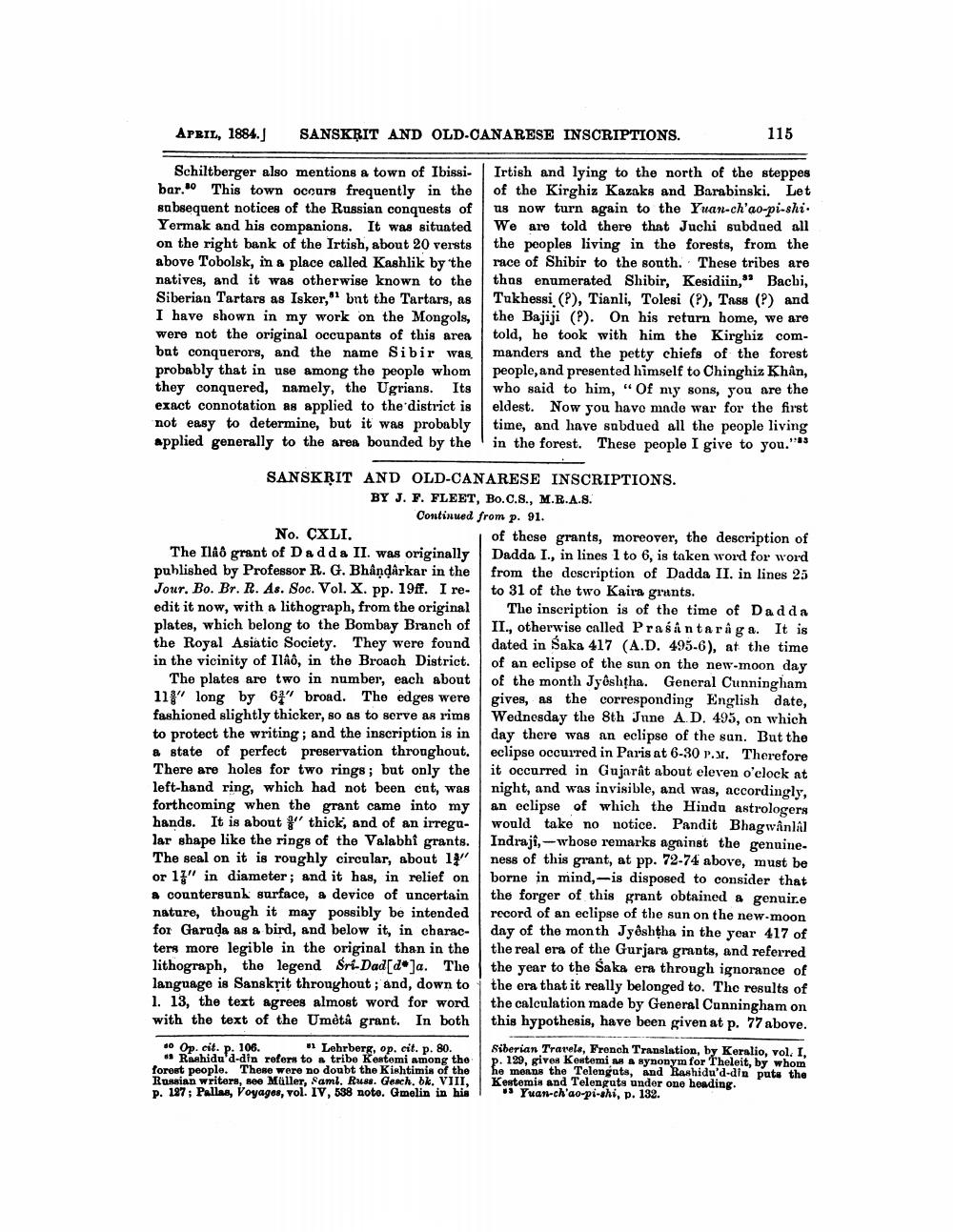________________
APRIL, 1884.
SANSKĶIT AND OLD-CANARESE INSCRIPTIONS.
115
Schiltberger also mentions a town of Ibissi- Irtish and lying to the north of the steppes bar. This town occurs frequently in the of the Kirghiz Kazaks and Barabinski. Let sabsequent notices of the Russian conquests of us now turn again to the Yuan-ch'ao-pi-shi. Yermak and his companions. It was situated We are told there that Juchi subdued all on the right bank of the Irtish, about 20 versts the peoples living in the forests, from the above Tobolsk, in a place called Kashlik by the race of Shibir to the south. These tribes are natives, and it was otherwise known to the thus enumerated Shibir, Kesidiin," Bachi, Siberian Tartars as Isker, but the Tartars, as Tukhessi (?), Tianli, Tolesi (P), Tass (?) and I have shown in my work on the Mongols, the Bajiji (P). On his return home, we are were not the original occupants of this area told, he took with him the Kirghiz combut conquerors, and the name Sibir was, manders and the petty chiefs of the forest probably that in use among the people whom people, and presented himself to Chinghiz Khan, they conquered, namely, the Ugrians. Its who said to him, “Of my sons, you are the exact connotation as applied to the district is eldest. Now you have made war for the first not easy to determine, but it was probably time, and have subdued all the people living applied generally to the area bounded by the 'in the forest. These people I give to you."***
SANSKRIT AND OLD-CANARESE INSCRIPTIONS.
BY J. F. FLEET, BO.C.S., M.R.A.S.
Continued from p. 91. No. CXLI.
of these grants, moreover, the description of The Tao grant of Dadda II. was originally Dadda I., in lines 1 to 6, is taken word for word published by Professor R. G. Bhåndarkar in the from the description of Dadda II. in lines 25 Jour. Bo. Br. R. As. Soc. Vol. X. pp. 19ff. I re- to 31 of the two Kaira grants. edit it now, with a lithograph, from the original The inscription is of the time of Dadda plates, which belong to the Bombay Branch of II., otherwise called Prasantaråga. It is the Royal Asiatic Society. They were found dated in Saka 417 (A.D. 495-6), at the time in the vicinity of Ilão, in the Broach District. of an eclipse of the sun on the new-moon day
The plates are two in number, each about of the month Jyôshtha. General Cunningham 11" long by 61" broad. The edges were gives, as the corresponding English date, fashioned slightly thicker, so as to serve as rims Wednesday the 8th June A.D. 495, on which to protect the writing, and the inscription is in day there was an eclipse of the sun. But the & state of perfect preservation throughout. eclipse occurred in Paris at 6-30 PM. Therefore There are holes for two rings; but only the it occurred in Gujarat about eleven o'clock at left-hand ring, which had not been cat, was night, and was invisible, and was, accordingly, forthcoming when the grant came into my an eclipse of which the Hindu astrologers hands. It is about thick, and of an irregu- would take no notice. Pandit Bhagwânlal lar shape like the rings of the Valabhi grants. Indraji, -whose remarks against the genuineThe seal on it is roughly circular, about 14" ness of this grant, at pp. 72-74 above, must be or 17" in diameter; and it has, in relief on borne in mind, is disposed to consider that * countersunk surface, a device of uncertain the forger of this grant obtained a genuire nature, though it may possibly be intended record of an eclipse of the sun on the new-moon for Garuda as a bird, and below it, in charac- day of the month Jyêshtha in the year 417 of ters more legible in the original than in the the real era of the Gurjara grants, and referred lithograph, the legend Sri-Dad[doja. The the year to the Saka era through ignorance of language is Sanskrit throughout; and, down to the era that it really belonged to. The results of 1. 13, the text agrees almost word for word the calculation made by General Cunningham on with the text of the Umètâ grant. In both this hypothesis, have been given at p. 77 above.
10 Op. cit. p. 106. " Lehrberg, op. cit. p. 80.
# Rashidu'd-din refers to a tribe Kentemi among the forest people. There were no doubt the Kishtimin of the Ranian writers, nee Müller, Saml. Russ. Gench, bk. VIII, p. 127; Pallas, Voyages, vol. IV, 538 note. Gmelin in his
Siberian Travels, French Translation, by Keralio, vol. I, p. 129, given Kentemi as a synonym for Theleit, by whom he means the Telenguts, and Rashidu'd-din puts the Kertemis and Telengats under one houding.
13 Yuan-ch'ao-pi-ahi, p. 132.




